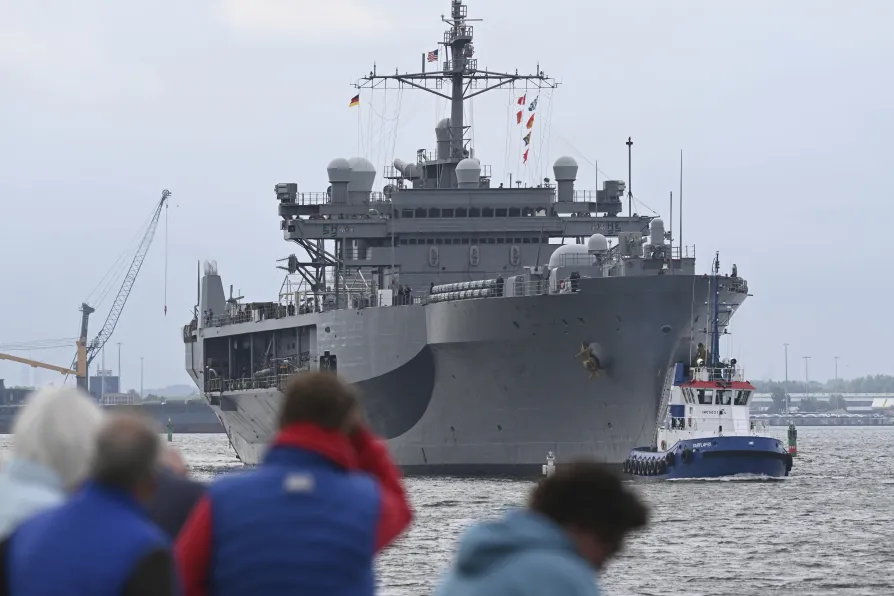Once the bustling heart of Christian pilgrimage, Bethlehem now faces shuttered hotels, empty streets and a shrinking Christian community, while Israel’s assault on Gaza and the tightening grip of occupation destroy hopes of peace at the birthplace of Christ, writes Father GEOFF BOTTOMS
SEVIM DAGDELEN argues that Israel’s attack on Iran represents the second front in Washington’s global three-front war strategy, with Germany leading the Ukraine proxy war against Russia so that the US can target China

 The US lead ship "USS Mount Whitney" sets course for the Baltic Sea at the start of the Baltic Operations (BALTOPS) NATO maneuver from the port of Warenmuende, Germany, June 5, 2025. Photo: Stefan Sauer/dpa via AP
The US lead ship "USS Mount Whitney" sets course for the Baltic Sea at the start of the Baltic Operations (BALTOPS) NATO maneuver from the port of Warenmuende, Germany, June 5, 2025. Photo: Stefan Sauer/dpa via AP
1. On June 13 2025, Israel launched an attack on Iran. This illegal act under international law would be inconceivable without the intensive support of the US, Nato and the EU. In fact, the US had been negotiating with Iran over its nuclear programme until the very last moment — apparently to create a false sense of security — while the military strike had already been decided.
It appears that Washington has opted for a global three-front war in order to defend US hegemony against the Brics countries and the global South. In Europe, Nato’s proxy war — led by Germany — continues in Ukraine against Russia, aiming to inflict a strategic defeat and break Russia as a geopolitical power bloc. EU foreign policy chief Kaja Kallas has openly named this as a war objective.
In the Middle East, Israel is waging a US-backed proxy war against Iran. The goal: to neutralise Iran as a strategic ally of Russia and China, and to disrupt China’s oil supply, in which Iran plays a crucial role. At the third front in east Asia, the US is concentrating its forces to challenge China. As with Germany and Ukraine in Europe, states and regions like Japan, the Philippines, and Taiwan are being developed into anti-China front-line states.
2. Waging a three-front war requires enormous military build-up. At the upcoming Nato summit in The Hague, a new defence spending target of 5 per cent of GDP is expected to be adopted — doubling current expenditures to around €3 trillion. Germany alone would spend €225 billion annually, nearly half of its federal budget, on military purposes.
Already today, the combined military expenditures of European Nato members exceed those of Russia by more than fourfold. This rearmament is not about defence. It is about enabling Nato to fight a world war against Russia, China and Iran simultaneously.
3. In Nato’s push to globalise and defend US hegemony, the control of straits, maritime trade routes and entire seas plays a central role. We are currently witnessing attempts to turn the Baltic Sea into a Mare Nostrum for Nato — a body of water where even international shipping routes, as well as access to the North Sea and the Atlantic, are subjected to Nato control.
One tool used in this effort has been EU sanctions on Russian tankers, enforced by Nato members like Estonia in the Baltic Sea. Although Nato was forced to pull back slightly due to Russian naval escorts of commercial ships, the strategic goal remains clear: to cut off Russia’s access to the Baltic, essentially reversing a geopolitical reality that has existed since the days of Peter the Great.
The illusion that Russia can be economically ruined and fragmented into smaller states remains a driving force behind this strategy.
4. Nato has been constructing extensive military infrastructure around the Baltic. This includes the new command centre in Rostock, which is deliberately not labelled as a Nato headquarters — doing so would constitute a clear violation of the German reunification treaty, which prohibits the stationing of foreign troops in the former East Germany.
Nato is pushing to expand the war zone against Russia by reigniting frozen cold war-era conflicts — such as the question of Russia’s maritime access. In 1946, the USSR withdrew from the Danish island of Bornholm under two key conditions: no Nato troop presence and unrestricted Russian naval passage to the Atlantic.
Both of these conditions now appear to be under threat. This is laying the groundwork for a dangerous maritime escalation of the war.
5. Nato’s rearmament for a three-front world war inevitably comes with a social war against its own population.
Though political leaders strongly deny it, the reality is plain to see: if half of the federal budget is directed toward military spending, this cannot be covered by debt alone. It will require deep cuts to pensions, public healthcare, education and infrastructure.
Germany and other Nato countries are being transformed into militarised states where core societal resources are funnelled into war readiness. The real winners of this development are US investment firms such as BlackRock, which hold significant shares in German arms manufacturers like Rheinmetall.
For them, war — and its preparation — is a booming business amid a crisis-ridden capitalism and falling profit rates.
It is time to push back against these war profiteers. What we need is a powerful alliance between workers in the global North and social movements in the global South.
Sevim Dagdelen is a former member of the German Bundestag.










